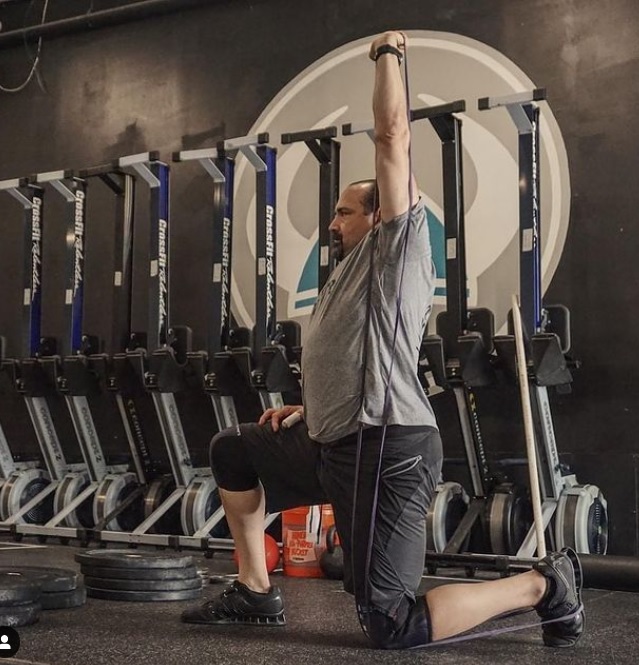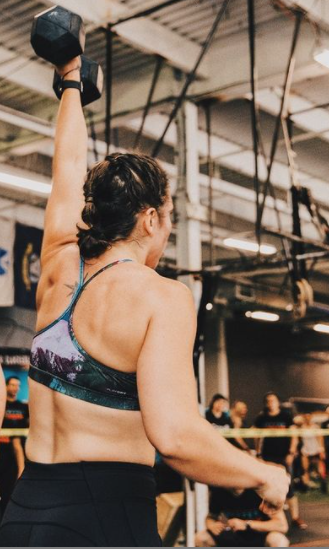Unilateral Movements
by Erik Castiglione
We had a strength only day this past Wednesday, and one of our accessory movements was the single arm floor press. I received the question “what percentage of my bench press should I use for weight?” And, I didn’t have a good answer. Why? Because it’s exceedingly difficult to translate a bilateral (both sides of the body) movement like the bench press into a unilateral (one side) movement.
When we performed this movement on Wednesday, you might have noticed that it felt extremely difficult compared to a bench press. I would guess that very few of us in the gym are ambidextrous, which means that we all have a dominant side. You may have noticed that using your dominant arm felt a little better than using your non-dominant arm. This is common, and it makes sense if you think about it – the arm you tend to use for more things in your daily life will naturally be stronger than the other. Unilateral training exposes this strength imbalance.
It’s not only useful for exposing strength imbalances, but also the best way to fix them. When we perform bilateral movements, especially those with a barbell, both sides of the body are connected as they apply force against the same object (the bar). The stronger side can compensate for the weaker side and save your lift. Over time, this can lead to overuse injuries in the strong side. And, it can cause the weaker side to compensate by using the wrong muscle group for the job at hand. This can lead to faulty movement patterns, and ultimately, injury. For all my runners out there, how many of you have ever had ankle, knee, or hip pain in one leg but not the other? Unless you had some sort of impact trauma (i.e., you banged that body part), that’s often the result of a muscular imbalance/compensation cycle. If you think of every stride as a repetition, and you’re running long distances, that’s a lot of repetitions during which your body improperly compensates for its imbalances.
In addition to exposing and fixing muscle imbalances, unilateral training unevenly loads your body, forcing you to work hard to stabilize yourself. This helps with core control and balance. If you’ve ever performed a suitcase carry vs. a farmers’ carry, you know what I mean. It’s much easier to balance and walk when you’re holding weights in both hands, than it is with just one. When we only load one side, the weight tries to cause our bodies to rotate. We have to recruit more muscles to prevent this rotation – it’s called anti-rotation, and it’s a big part of stability training. Bilateral training requires bracing, unilateral training requires bracing and anti-rotation. And by improving balance, stability, and muscle imbalances through unilateral training, we can help both sides to work together evenly, thereby improving bilateral movements as well. The reverse isn’t necessarily true.
Unilateral movements are also a great way to get a good training effect with less load. During the shutdown, we pivoted our training approach to virtual classes, and we assumed that most people didn’t have much equipment to work with. By using unilateral movements with only a DB or KB, we were still able to create challenging and effective workouts with less weight than we’d like to have at our disposal.
Finally, unilateral movements are great for training around injuries. We can adjust our bodies and move in different joint angles that we might not be able to target with bilateral movements. We frequently use the landmine for different exercises on our strength only days. Think about the numerous movement variations you’ve done with them – lateral squats and lunges, presses at an incline rather than horizontal or vertical, different rows, the list is endless. With unilateral training, we can find creative ways to scale our movements so that you’re still training the pattern that we want, while avoiding painful ranges of motion, and avoiding loads that hurt. For example, an athlete who has pain while strict pressing a bar overhead might find the single arm landmine press to be pain free (and equally, if not more challenging!).
Or, in the case of recovery from an injury, we can train the healthy side only. If, God forbid, you find yourself in a sling with an immobile arm, you can still train your good arm. There’s a training principle called transference, where if you train one side, you’ll preserve strength in the other. The injured side won’t gain strength, and you’ll still need to rehab it, and once you’re healthy again, try to get it equal with the non-injured arm, but at least you can prevent a complete loss of strength. If you’ve ever been in a cast, you know that your muscles atrophy a bit, and that body part looks skinny compared to its opposite when the cast is removed. Better to lose just muscle mass, rather than muscle mass and strength. Unilateral training can help with this.
As you can see, there’s tremendous benefit to unilateral exercise, so as much as it may suck, we’re going to continue including it in our programming. And, if you put in the work, you’ll reap the benefits of these movements. I hate lunges as much as the next person, but they’re a staple for me, and my squat has improved as a result. Yours will too. See you in the gym.


